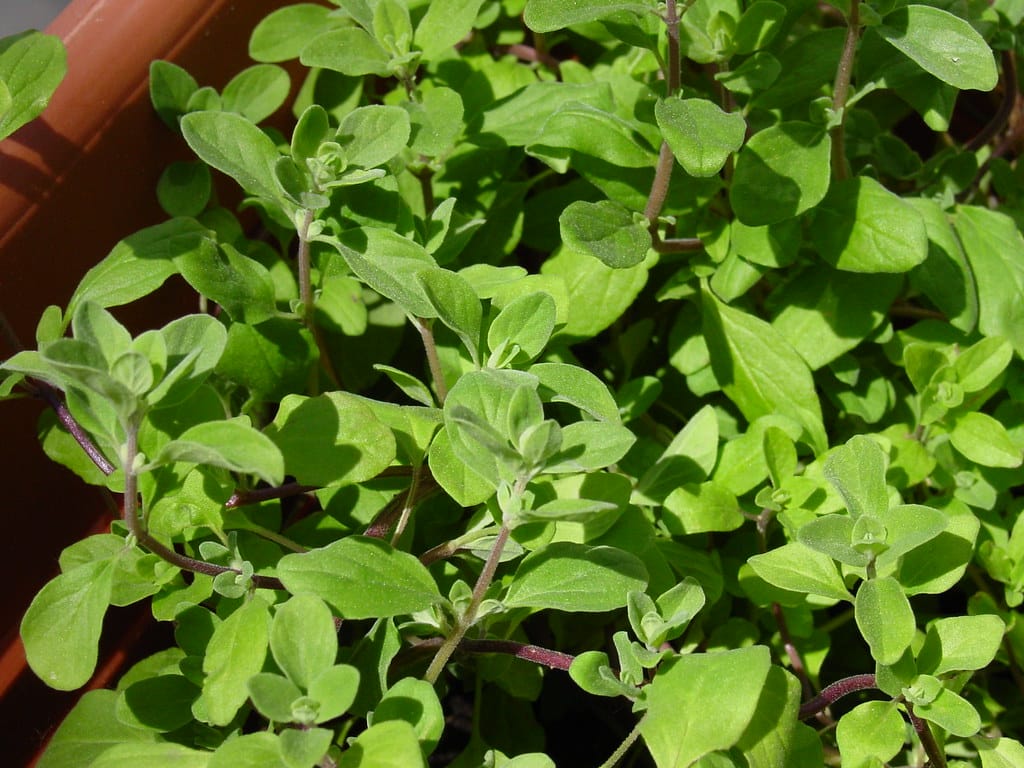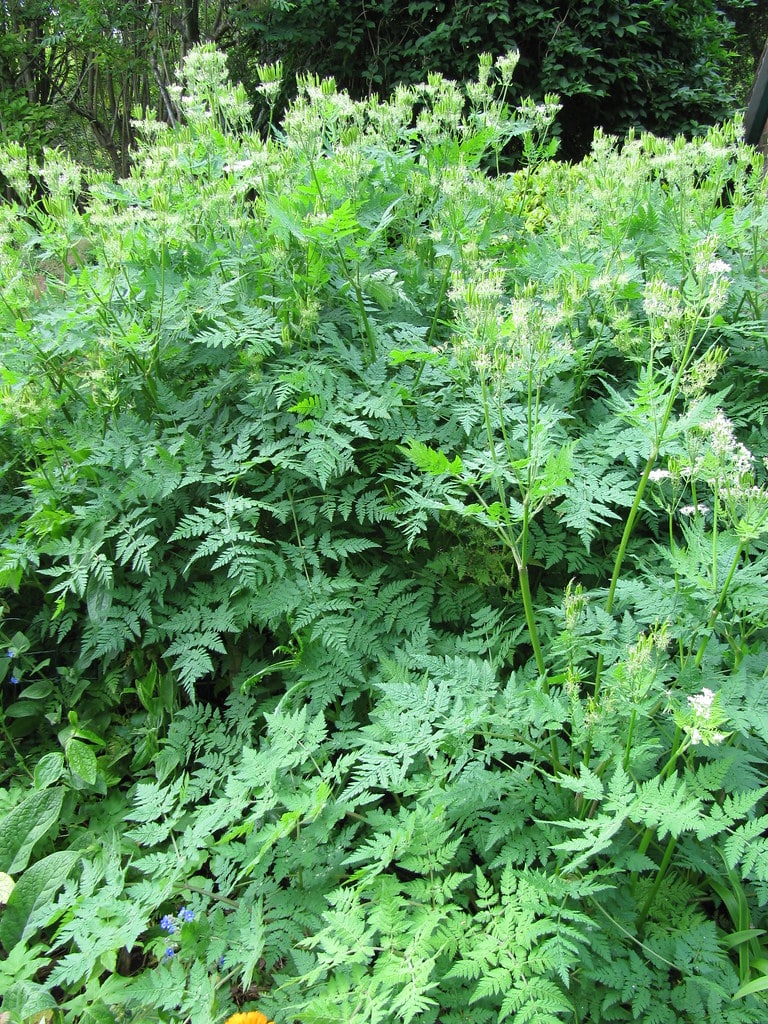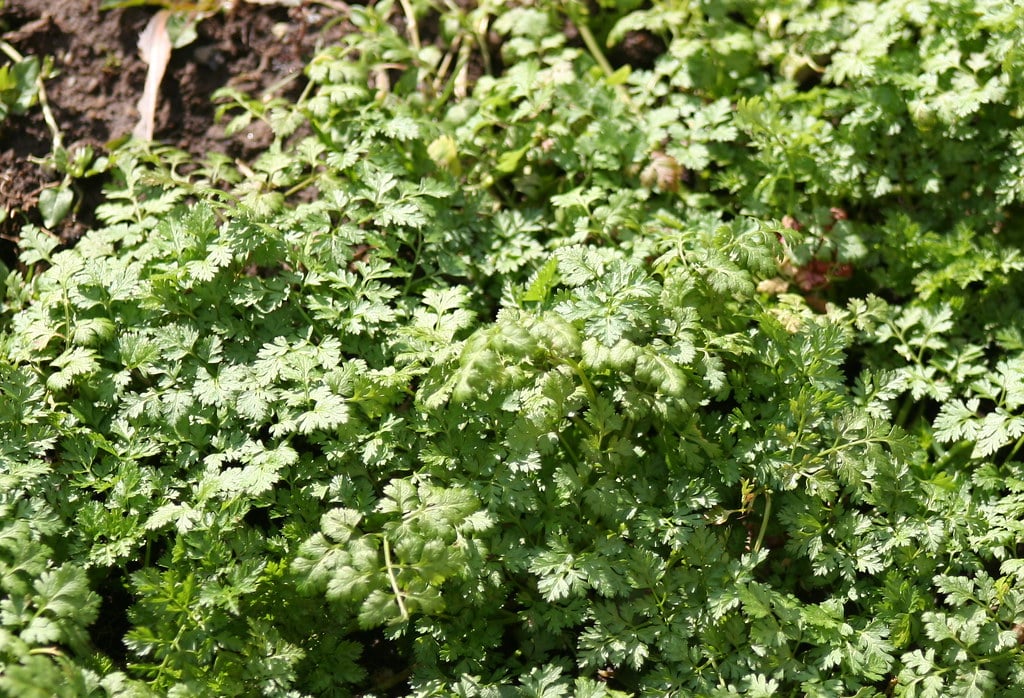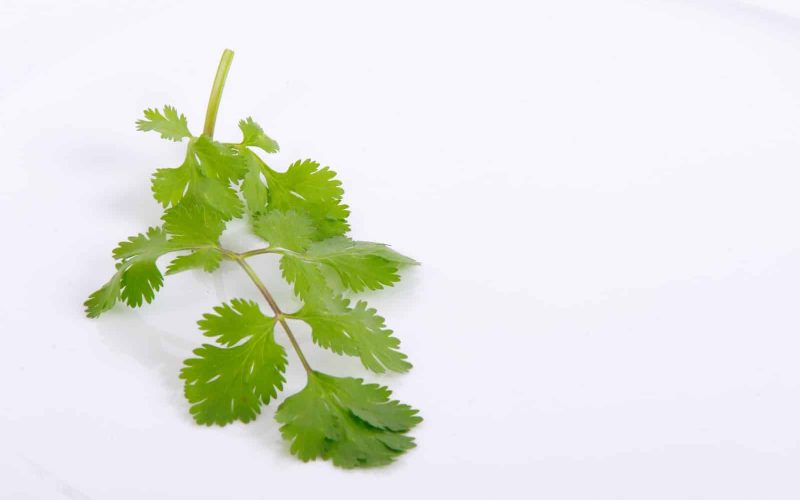Herbs are a great way to flavor any dish and are incredibly easy to use.
You can take your culinary creations to the next level with just a pinch and different culinary herbs.
Let’s dive into different culinary herbs that you can use to transform your cooking.
From subtle flavors to bold and spicy notes, culinary herbs can add an extra dimension to your dishes.
We’ll also look at how to store and use fresh herbs to get the most out of them.
Read on to learn more about the different culinary herbs and how they can add flavor and texture to your food!
1. Marjoram

This comes first on our list of different types of culinary herbs. Marjoram is an incredibly versatile culinary herb with a sweet, fragrant flavor.
It has small, greenish-gray leaves and tiny white flowers. It tastes similar to oregano but is a bit milder and slightly sweeter.
Marjoram pairs well with many different ingredients and can be used in soups, sauces, salads, marinades, vegetables, and meats.
It is also commonly used as a garnish or in herbal teas. Marjoram has long been known to have numerous health benefits, including aiding digestion and preventing respiratory infections.
When using marjoram in cooking, adding it near the end is best to preserve its flavor and aroma.
2. Sweet Cicely

Second, Sweet Cicely is on the list of different culinary herbs. It is an herb that can be used in various recipes.
It has a unique sweet taste that can enhance the flavor of many dishes. Sweet Cicely has a hint of aniseed, giving it a unique and pleasant aroma.
It is native to Europe and parts of Asia but is also grown in some parts of North America and Australia.
Sweet cicely leaves can be used as a garnish on salads or as an ingredient in soups and stews.
It can also flavor vinegar, jellies, jams, and preserves. The seeds of this herb can be dried and used to make tea or season meats.
Sweet cicely is a great way to add depth of flavor to dishes without adding extra fat or calories.
3. Basil

Basil is one of the different types of culinary herbs used in cooking.
It has a sweet yet strong flavor adds depth and complexity to many dishes, including soups, sauces, salads, marinades, and even desserts.
Basil has been used in cooking for centuries and has many health benefits, including being high in antioxidants, anti-inflammatory compounds, vitamins, minerals, and fiber.
Basil can be found fresh or dried and used in savory and sweet recipes. Whether you’re an experienced cook or just starting, basil makes your dish delicious!
4. Oregano

Oregano is an essential culinary herb that is widely used in a variety of dishes. It is native to the Mediterranean and has a strong, spicy flavor.
Oregano can be used in fresh or dried form and is especially popular in Italian and Greek cuisine. It is often used to flavor sauces, salads, pizzas, and soups.
Oregano is also known for its many health benefits, such as providing antioxidants, fighting inflammation, and boosting the immune system.
It is also a great source of vitamins and minerals such as vitamin K, iron, and calcium.
5. Rosemary

Rosemary is an herb with a pungent, pine-like aroma commonly used in Mediterranean cooking.
It has a slightly bitter flavor that can be used to enhance the flavor of poultry, fish, and vegetable dishes.
Rosemary is also used to season sauces, soups, stews, dressings, and marinades.
It pairs especially well with garlic and olive oil, creating a classic Italian combination.
Rosemary contains antioxidants and is known to have antibacterial and anti-inflammatory properties, making it one of the different culinary herbs beneficial for overall health and wellness.
6. Thyme

Thyme is a fragrant, woody herb used in cooking and medicine for centuries.
It is often used as an aromatic seasoning in various dishes, and its flavor works well with poultry, fish, lamb, beef, and vegetables.
The leaves of the thyme plant can be used fresh or dried and are often used to flavor soups, stews, and sauces.
Also, thyme has antibacterial properties, making it a beneficial ingredient for many dishes.
It is a popular choice for many culinary creations due to its unique taste and ability to add flavor to any meal.
7. Parsley

Parsley is one of the most popular culinary herbs, and it is used around the world in many dishes.
This herb has a mild, slightly sweet flavor and is often used to add color and texture to a dish.
It’s an excellent source of Vitamins A, C, and K and can help support digestion and gut health.
You can use it fresh or dried in various dishes, from salads to sauces and soups.
Add parsley to garnish on your favorite pasta or risotto dish for extra flavor and nutrition.
8. Chives

Chives are an Allium family member and have a mild onion-like flavor.
These thin, grassy green stalks can be used as a garnish or added to a dish for flavor.
Chives are commonly used to flavor salads, omelets, potatoes, and soups.
They are also a great topping for baked potatoes and pair wonderfully with sour cream or Greek yogurt.
Chives are low in calories but high in essential vitamins, minerals, and fiber.
The health benefits of chives include improving digestion, boosting the immune system, and reducing inflammation.
In addition to their culinary uses, chives are popular for their ornamental appeal in flower beds and container gardens.
9. Sorrel

The next on our list of different types of culinary herbs is Sorrel.
It is a herb that adds a tangy, lemony flavor to dishes. It has long, narrow leaves and a slightly sour taste.
Sorrel can be eaten raw or cooked and can be used to add flavor to salads, soups, sauces, and other dishes.
It is also an excellent source of vitamin C and other nutrients, making it a healthy and flavorful addition to your diet.
Sorrel has a mildly bitter flavor that pairs well with fish, poultry, and vegetables, making it a great choice for adding a punch of flavor to many dishes.
10. Dill

Dill is also one of the different culinary herbs with a sweet, slightly spicy flavor.
It is most commonly used to enhance the flavor of fish and other seafood dishes, but it can also be used in soups, salads, sauces, and more.
It’s a great addition to any meal, as it brings out the flavors of the other ingredients without overpowering them.
The leaves can be used fresh, dried, or frozen for later use. With its unique flavor, dill will surely add something special to your cooking!
11. Peppermint

Peppermint is a versatile herb that can be used in many dishes. Its strong flavor is refreshing and cooling, making it an ideal choice for light summer salads or marinades.
It can also be steeped in hot water to make a delicious herbal tea.
In addition to its culinary uses, peppermint has many medicinal benefits and can treat indigestion, headaches, and cold symptoms.
It can also be added to essential oils for aromatherapy. Peppermint is a fragrant, flavorful herb that will bring a unique flavor to any dish.
12. Chervil

Chervil is a delicate and fragrant herb with an anise-like flavor. It has small, fern-like leaves and a mild, slightly sweet taste.
Chervil is widely used in French cooking, where it is often combined with other herbs such as tarragon, parsley, and chives to create classic combinations such as fines herbes.
The herb pairs especially well with fish and egg dishes, salads, soups, and sauces.
Its light, slightly sweet flavor makes it ideal for adding a unique flavor to your culinary creations.
13. Shiso

Shiso is one of the most popular culinary herbs originating in East Asia.
It has a pungent aroma and flavor and is commonly used in Japanese and Chinese cuisines.
Shiso leaves are usually served raw or cooked, often as an accompaniment to sushi.
They can also make tea and flavor sauces, soups, pickles, and stir-fries.
The leaves can be dried as a seasoning or garnish in salads and other dishes.
The health benefits of shiso include improving digestion, reducing inflammation, and protecting against certain forms of cancer.
Shiso also contains high levels of vitamin A, calcium, and iron, making it a nutritious addition to your diet.
14. Lemongrass

Lemongrass is an aromatic herb native to Asia that has been used in traditional cuisines worldwide for centuries.
The leaves of this fragrant herb have a unique lemony scent and flavor and are often used in Asian cuisine.
Lemongrass is a key ingredient in many Thai and Southeast Asian dishes, such as curries, soups, and stews.
It’s also used to flavor drinks and teas and can be added to baked goods for a lemony flavor.
Lemongrass is known for its anti-inflammatory and antioxidant properties, making it a great addition to any health-conscious diet.
Whether you’re cooking up something new or want to spice up your favorite dish, lemongrass is an herb that can transform your culinary creations.
15. Bay

Bay is an aromatic herb that is known for its distinctive flavor. It is native to the Mediterranean and the Middle East but has been used in cooking for centuries.
Bay leaves are usually dried and generally added at the beginning of a dish to allow the flavor to infuse into the food.
Bay leaves have a unique flavor that can be described as spicy and sweet.
These different culinary herbs pair well with other herbs, such as thyme and oregano, as well as meats and stews.
Additionally, bay leaves are thought to have medicinal properties and have been used in traditional medicines to treat various ailments.
16. Leaf Celery

Leaf celery, also known as Chinese celery, is a popular culinary herb in many Asian dishes.
It is distinguished from regular celery by its thinner, more delicate stalks, leaves, and intense flavor.
Leaf celery can be eaten raw or cooked with a mild, slightly sweet taste that is perfect for adding to soups, salads, and stir-fries.
It is also often used as a garnish or to add color and flavor to dishes.
Leaf celery contains vitamins A and C and minerals such as potassium and magnesium, making it a nutritious addition to any meal.
17. Cilantro

Cilantro, also known as coriander, is an aromatic herb that adds a fresh and citrusy flavor to many dishes. Its leaves have a pungent, spicy aroma that is unmistakable.
Cilantro is widely used in many cuisines worldwide and is particularly popular in Mexican, Latin American, Middle Eastern, and South Asian dishes.
It can be eaten raw or cooked, but it’s best used in its fresh form for maximum flavor. Its seeds are also used for flavoring and garnish.
Cilantro has many health benefits, such as improved digestion, lowered cholesterol, and anti-inflammatory and anti-cancer benefits.
Its aroma and flavor make it a valuable addition to any dish, making It one of the culinary herbs that is a great way to add some zest to your culinary creations!
18. Fennel

Fennel is an incredibly versatile culinary herb used in cooking for centuries.
It has a distinctive, sweet, and aromatic taste, and its feathery fronds can be used as a garnish or chopped up and added to salads, soups, and other dishes.
Also, Fennel makes a great addition to fish and pork dishes, giving them a unique flavor that can’t be achieved with any other herb.
Its seeds can be dried and used as a spice, and its leaves can be used in herbal teas.
Fennel is one of the different types of culinary herbs that is an excellent source of dietary fiber and vitamins, and its antioxidants may help protect against certain forms of cancer.
Adding fennel to your meals is an easy way to give them extra flavor and nutritional benefits.
19. Lemon Balm

Lemon balm is a fragrant herb with a tart, lemony taste. It’s widely used in cooking and baking but also has medicinal qualities.
In the culinary world, lemon balm makes teas, desserts, and salads.
This is one of the different culinary herbs that pairs well with fruits like apples, oranges, and blueberries.
Lemon balm can also season roasted vegetables, chicken, pork, and fish dishes.
The plant leaves have a strong aroma and are often used as an aromatic garnish in various dishes.
Lemon balm is high in vitamins C and A and minerals such as potassium, iron, and magnesium.
It’s known for its calming properties, making it a popular herbal remedy for stress, anxiety, and insomnia.
20. Nasturtium

Nasturtium is a culinary herb that provides a unique flavor to dishes. It has a slightly peppery and sweet taste; its flowers and leaves are edible.
It is easy to grow, making it a great choice for home gardens. Nasturtium can be used in salads, sauces, soups, pasta, and other recipes.
Its vibrant colors add an extra splash of color to any dish. Nasturtium is rich in vitamins A, B, and C and has a high concentration of minerals such as iron and magnesium.
Its health benefits also include being antibacterial, anti-inflammatory, and antifungal.
21. Salad Burnet

Salad burnet is an herb with a mild cucumber flavor and can enhance the flavor of salads and other dishes. The salad burnet leaves are small, round, and bright green.
It can be used as a garnish, an ingredient in sauces, or a flavoring in teas and other drinks.
The leaves have a slightly tart taste, but when cooked, they become sweeter.
Salad burnet is also full of vitamins, minerals, and antioxidants, making it a healthy dish addition.
22. Common Sage

Common sage, a member of the mint family, is one of the most popular culinary herbs used in cooking.
It has a distinctive aroma and flavor pairs well with other herbs like thyme and oregano.
Sage can be used fresh or dried and is a popular addition to soups, sauces, stews, stuffings, poultry dishes, and even some desserts.
It’s known for its strong flavor and ability to bring out the flavor of other herbs and spices.
Common sage can also help to reduce inflammation and is often used as a remedy for digestive problems.
Sage also has antioxidant properties that make it beneficial for general health.
23. Summer Savory

Summer savory is a great culinary herb that adds flavor to any dish. It is used in many different cuisines, from Italian to Mexican.
This herb has a strong, earthy flavor and is often used in savory dishes like sauces, stews, soups, stuffing, and dressings.
Savory is one of the different culinary herbs that can be used fresh or dried for maximum flavor and aroma.
Using savory sparingly is important as its intense flavor can overpower other ingredients.
Some common savory uses include roasted meats, grilled vegetables, salad dressings, marinades, and tomato-based sauces.
24. Tarragon

Tarragon is an incredibly versatile herb used in French cooking for centuries.
Its unique flavor and aroma make it a popular addition to many dishes.
Tarragon can be used fresh, dried, or frozen to add a bright, anise-like flavor to sauces, salads, soups, and stews.
It pairs well with other herbs such as oregano and thyme and is an essential ingredient in the classic French sauce Béarnaise.
It also adds depth of flavor to poultry, seafood, and beef dishes.
Additionally, its leaves can be used as an herbal tea for an invigorating and relaxing drink.
25. Lovage

This is the last on our list of different types of culinary herbs. Lovage is a bold and assertive herb with an intense celery-like flavor.
It’s an ancient plant used in herbal medicine during the Middle Ages.
Lovage leaves can be used fresh or dried for teas and infusions, and their seeds and roots can be used for spice blends.
Its leaves make great additions to soups and salads, adding a unique flavor and texture. Lovage is also commonly used as a garnish in various dishes.
Its intense flavor adds complexity and depth to any dish, making it an excellent addition to any chef’s herb garden.








